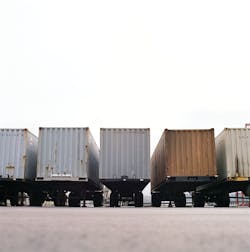Proper vehicle alignment is a major area of concern because of its direct implications on the life of tires, fuel economy and safety. Alignment is often thought of in connection with a truck’s steer axles only. However, the rear axles on a tractor also must be properly aligned, and tractor and trailer units need to be aligned with each other (in combination vehicles) for optimal performance.
Fleet experience and industry research shows that misalignment can cause a variety of problems, including:
- Irregular tire wear. Misalignment cause tires to scrub and oppose each other. What’s more, excessive and/or uneven tire wear can reduce control of steering inputs, particularly on low-friction surfaces like wet pavement, which compromises the vehicle operator's ability to execute quick, precise maneuvers.
- Fuel economy. Misalignment between front and rear axles on a tractor, and/or between the tractor and trailer units themselves, creates dog-tracking going down the road. This, in turn, causes the engine to work harder because rolling resistance is increased, and fuel economy suffers.
Dog-tracking is a condition where the rear end is offset from the front. In the case of a tractor trailer, the trailer is offset from the tractor.
- Vehicle vibration. Misalignment conditions can also often lead to higher-than-normal vibration levels in the steering wheel and/or the operator's seat. The result can be an uncomfortable ride that contributes to driver discomfort, muscular fatigue and stress.
Trailer misalignment will also cause increased tire wear, greater aerodynamic drag, reduced stability and diminished fuel economy. Essentially, trailer alignment involves adjusting trailer components to line up according to three parameters - axle orientation, axle toe and axle camber - so that the trailer tracks straight and true.
COSTS ADD UP
Regardless of the type of vehicle, one that is poorly aligned can reduce the driver's level of control, which then adversely affects vehicle stability and has negative consequences for operating costs, says John Messina president-elect of Truck frame and Axle Repair Association (TARA) and president of Tampa Spring Company.
TARA is the premier group in North America whose focus is on quality frame and axle repair and maintenance of trucks, trailers, RVs and heavy equipment vehicles. www.taraassociation.com.
Founded in 1927, Tampa Spring Company is family owned and operated with four shops in Central Florida specializing in suspension overhauls for trucks and trailers; frame repair, straightening and modifications; complete wheel alignments; and many other shop services. www.tampaspringco.com.
“In this day of $4 per gallon diesel fuel, pulling a loaded trailer that is not in alignment with the tractor will increase the cost of operation per mile by cutting fuel economy,” Messina says. “The truck engine will have to run at a higher rpm to compensate for the extra drag of the trailer.
“Tires will prematurely wear and have to be replaced more often. The price of tires has been increasing along with the price of petroleum, as this is the major component in the manufacture of tires.”
SEMITRAILER LIFTING
When you need to lift a trailer that is detached from the tractor, the logistics and safety requirements can be challenging, even for the most experienced fleet operator or service technician.
The majority of trailers are serviced and inspected outside. Further, in contrast to the more straightforward requirement of lifting a full rig - which can be accomplished with a range of options, including mobile column lifts, axle engaging scissor lifts, platform lifts or inground piston lifts, lifting a trailer on its own presents a number of unique structural demands.
“The goal is to pick up and support the chassis of the trailer in the same manner as it is normally supported when on the road and supported by the fifth wheel,” explains Peter Bowers, technical sales support manager for Stertil-Koni, the global market leader in heavy duty truck lifts and bus lifts. www.stertil-koni.com. “At issue is how best to support the trailer frame, which supports the trailer when it is not hooked to the tractor.”
The solution, according to Stertil-Koni, is to use four, heavy duty mobile column lifts - two at the wheels and two utilizing a kingpin cross beam that engages the trailer at the fifth wheel.
SAFETY FIRST
With trailer lifting, “safety, of course, is paramount,” Bowers emphasizes, “Before you begin, always lift on a firm foundation. Lift on level ground and be aware of wind loads.”
“Next, bring in mobile lifting columns to the rear-most axle and maneuver the cross beam into place, locating it properly under the kingpin. At that point, engage the mobile lifting columns to the cross beams.
Stertil-Koni recommends using battery powered, wireless mobile lifting columns, says Bowers. “In this way, an external power source is not required and it eliminates the possibility of the operator tripping due to messy wires or cables.
SPECIALIZATION
In today’s environment, many fleets are not taking the time, nor making the investment, to have trailer alignments done at shops that specialize in alignment and frame repair, observes Messina. Typically, this is done to avoid both the expense in moving trailers to these shops and the loss of revenue for the time they are out of service.
Messina notes that there are mobile alignment services that some fleets have opted to use to get away from the time and expense of taking a trailer to a specialist facility, “but in the field, the only work that can be completed is to set the axles to the centerline of the fifth wheel kingpin. Axle camber and toe in cannot be repaired.”
Messina says a good trailer alignment would encompass the following:
- The alignment provider would ask insightful questions of the truck driver to determine what problems he is having.
- All suspension components would be inspected and replaced if worn.
- Trailer axle camber and toe would be checked to make sure that the axles are not bent.
- Trailer alignment equipment will be mounted to check the geometry of the rear axles in relation to the fifth wheel kingpin.
TRAILER AXLE MAINTENANCE
“An important thing to remember about trailer axle maintenance is that it is not the beam that requires most of the maintenance; it’s the components that are attached to it,” points out Keytoria S. King, product manager of trailer systems at Meritor, a leading global supplier of drivetrain, mobility, braking and aftermarket solutions for commercial vehicle and industrial markets. www.meritor.com. “Components should be regularly inspected for damage, wear, repair or replacement to prevent safety related incidents from occurring on the road.”
Instituting a regular inspection and maintenance schedule helps to reduce downtime and repair costs, while insuring vehicles meet state and federal regulations, Kings says. “Trailer axles should be inspected every six to 12 months. By doing so, the potential for costly breakdowns will be greatly reduced.”
Meritor provides the following recommendations:
Regular Component Inspections
1. Fasteners and tapped holes
+ Replace damaged fasteners and repair damaged tapped hole threads with the correct sized die.
2. Hubs and bearings
+ Ensure that they are thoroughly cleaned, inspected and re-lubed.
+ Inspect for proper wheel bearing end play and seal leakage.
+ Replace bearing(s) if there are signs of wear, discoloration, roller cage damage, grooves, etches, cracks, etc.
+ Inspections and maintenance should be performed according to specifications in TMC RP 622A, Wheel Seal and Bearing Removal, Installation and Maintenance.
3. Brake spider
+ If cracks are found, replace the axle immediately.
+ If the weld on camshaft retainer is either damaged or worn, it can be replaced.
4. Automatic Slack Adjusters (ASA) and air chambers
+ It is common practice that ASA should not require manual adjustments in service. Refer to the manufacturer’s specifications to confirm.
+ The air chamber and ASA must be installed at the correct angle to ensure proper brake performance. Refer to the manufacturer’s specifications to inspect the angle.
5. Camshaft and camshaft bushings
+ Monitor for camshaft bushing wear and replacement.
+ Lubricate the entire area of the spline that comes in contact with the ASA.
+ Apply the specified grease to the camshaft bushing as specified by the manufacturer.
6. Lubrication
+ Before performing lubrication procedures on the cam bushings and ASA, release the brakes to ensure sufficient lubrication.
+ To ensure that contaminants have been flushed, add fresh grease until new grease appears at the purge point at components that require lubrication.
+ Refer to the component and lubricant manufacturer’s specifications to confirm that the selected grease is compatible.
+ Inspect wheel end oil levels as specified by the manufacturer and add oil as directed.
Axle Beam Inspection
1. Cracks
+ Any cracks found on the axle tubing require that the axle be replaced.
+ Repair the crack if it’s located at a weld and there is not a risk for the crack to penetrate to the tube. Weld repairs should conform to TMC RP 728, Trailer Axle Maintenance.
+ Repairs at areas where brackets have been welded to the beam are allowed.
2. Straightness (not to be confused with axle camber)
+ Signs that a bent beam problem exists are excessive or premature tire wear.
+ Refer to the manufacturer’s specifications for straightness requirements.
3. Spindle
+ Cracks
- If found, replace the axle immediately. Repairs are not allowed. Do not use outside spindle repair contractors.
+ Scratches, rust, pitting
- Polish or sand with an emery or crocus cloth.
- If 50 percent or more of the spindle surface has visible scratches, rust or pitting, an immediate replacement of the axle is required.
- Do not reduce the diameter of the journal beyond the axle manufacturer’s specifications.
+ Threads
- Repair damaged threads with the correct die.
“When developing your inspection and maintenance schedules, always refer to the axle and component manufacturer’s specifications to ensure that you do not void your warranty,” stresses King. “In addition, the TMC Recommended Practice Manual highlights best practices for trailer axle maintenance.”
This information is for quick-reference purposes only, and is in an abbreviated form, King points out. For copies of all manuals, instructions, cautions and warnings associated with repairing Meritor products, visit www.meritor.com/customer/northamerica/lod/default.aspx.
About the Author

